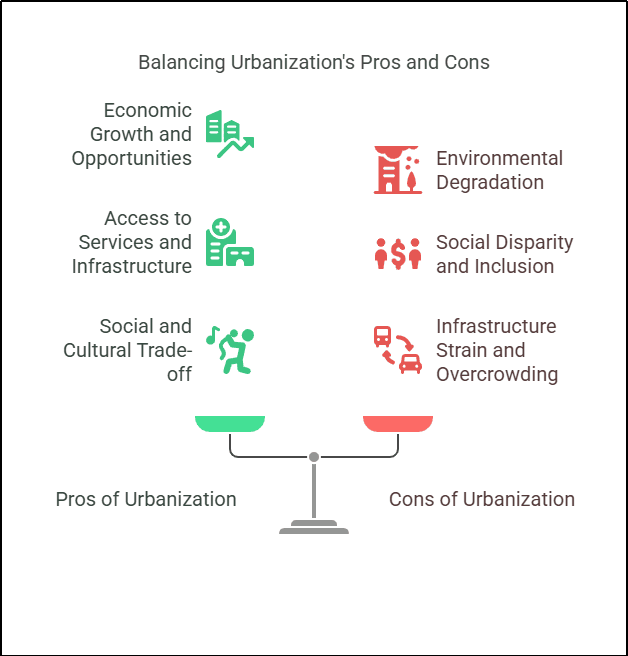The reorganization of societies around the world has been taking place since urbanization as the concentration of populations in cities is the leading cause of economic, social, and cultural changes (Beissinger, 2022). More than half of the global population lives in cities, which is expected to rise to 68 percent by 2050. Although urbanization brings about economic development, innovation and culture mix, it also comes with several challenges such as environmental degradation, social inequality, and infrastructure pressure. This essay looks at both advantages and disadvantages of urbanization so as to come up with a balanced view.

Figure 1 Pros and Cons of Urbanisation
Pros of Urbanization
Economic Growth and Opportunities
Economic development is triggered by urbanization. Cities bring together resources, labor and infrastructure, which provide economies of scale, which in turn bring about productivity. Cities are the sources of high contributions to global GDP although they cover a little portion of the land. Businesses are drawn to cities, where they create employment opportunities in technologies, finance, and production. The existence of talents and related infrastructure in urban centers such as Silicon Valley is a prime example of how innovation and entrepreneurship thrive due to concentration (Spirou, 2021).
Cities also offer a variety of jobs, which rural migrants pursue in the search of improved livelihood. In developing countries, including India and Nigeria, urbanization has also decreased poverty levels by providing the residents with access to better paying jobs and the ability to start businesses. Agglomeration takes place in urban economies whereby due to close proximity, transportation costs are lowered and accessibility to market improves which in turn amplifies economic production.
Access to Services and Infrastructure
With urbanization, there is increased access to basic services such as healthcare services, education and transport. In the cities, hospitals, schools and the public transport system are usually better equipped than in the rural settings. The accessibility of quality healthcare services by the residents of urban areas is far much better than those living in the rural set up. The living standards are also enhanced as centralized infrastructure like water supply and electricity is cheaper to distribute in high density residence.
The urban centers also abound in education opportunities. Higher education institutions such as universities and vocational training centers are usually based in urban areas, making higher education and skills training accessible (Gallagher, 2022). Such concentration leads to the development of human capital, very essential in the long-term economic growth.
Social and Cultural Trade-off
Urban areas are crucibles of cultures, which encourage diversity and innovation. Urbanization promotes the contact between different people, thus bringing cultural exchange and creativity. Multicultural cities such as London or New York are the global cultural centers which are filled with various festivals, museums and communities which make the social life there very rich. This variety creates new ideas, with different minds comes creativity in matters such as arts, technology and even food.
Another benefit is social mobility. The cities provide networks and possibilities of individuals to ascend the socioeconomic ladder (Danish et al., 2025). Access to diverse labor markets and social networks because of urban settings is associated with greater upward mobility of low-income families.
Cons of Urbanization
Environmental Degradation
The urbanization is usually costly to the environment. High rates of urban development are contributing towards deforestation, biodiversity depletion and pollution. The urban sprawl has been linked to a lot of carbon emissions on the globe; this is contributed majorly through transport means and industrial processes. Such cities as Delhi or Beijing are faced with the challenge of air pollution, and the concentration of particulate matter regularly differs with safety limits, affecting the health of the population (Anwar et al., 2021).
Climate change is made worse by urban heat islands where concrete and asphalt keep the heat. Urban regions may be many degrees hotter than the nearby rural areas, raising cooling energy requirements. Moreover, in fast urbanizing cities, problems with waste management result in the overflow of landfills and water pollution, as observed in such cities as Lagos.
Social Disparity and Inclusion
As much as there are opportunities associated with urbanization, it also increases inequality. The prohibitive living expenses in urban areas especially the cost of housekeeping, lockout low-income populace in the possession of urban advantage. In global cities like Mumbai and San Francisco, housing affordability has declined, with many residents spending a large portion of their income on rent. This creates urban slums and informal settlements, where residents face poor living conditions and limited access to services.
Social exclusion is another issue. Marginalized groups, including migrants and minorities, often face discrimination in urban job markets and housing (Hanhörster and Lobato, 2021). Rural-to-urban migrants frequently end up in precarious employment, perpetuating cycles of poverty.
Infrastructure Strain and Overcrowding
Rapid urbanization strains infrastructure, leading to overcrowding and reduced quality of life. Traffic congestion, inadequate public transport, and overburdened utilities are common in fast-growing cities. Cities like Jakarta lose billions annually due to traffic congestion, impacting productivity and well-being. Overcrowding also exacerbates health risks, as seen during pandemics, where densely populated urban areas faced higher infection rates (Lall and Wahba, 2021).
Public services like water supply and sanitation often lag behind population growth. In some regions, a majority of urban residents lack access to adequate sanitation, leading to health crises like cholera outbreaks.
Conclusion
Urbanization is a double-edged sword. It drives economic growth, improves access to services, and fosters cultural exchange, but it also creates environmental, social, and infrastructural challenges. Policymakers must balance these pros and cons through sustainable urban planning, affordable housing initiatives, and investments in green infrastructure. As urbanization continues, addressing these challenges will be critical to ensuring cities remain engines of progress without compromising equity or sustainability.
References
- Anwar, M.N., Shabbir, M., Tahir, E., Iftikhar, M., Saif, H., Tahir, A., Murtaza, M.A., Khokhar, M.F., Rehan, M., Aghbashlo, M. and Tabatabaei, M., (2021). Emerging challenges of air pollution and particulate matter in China, India, and Pakistan and mitigating solutions. Journal of Hazardous Materials, 416, p.125851.
- Beissinger, M. R. (2022). The revolutionary city: Urbanization and the global transformation of rebellion. Princeton University Press.
- Danish, S., Mahmood, T., Rehman, A., Usman, A., & Sadaf, F. (2025). Networks of Opportunity': Unpacking the Role of Family, Peers, and Community in Shaping Economic Mobility in Low-Income Urban Settings. The Critical Review of Social Sciences Studies, 3(1), 313-324.
- Gallagher, S. R. (2022). The future of university credentials: New developments at the intersection of higher education and hiring. Harvard Education Press.
- Hanhörster, H., & Lobato, I. R. (2021). Migrants' access to the rental housing market in Germany: Housing providers and allocation policies. Urban Planning, 6(2), 7-18.
- Lall, S. V., & Wahba, S. N. (2021). Crowded cities: new methodology in COVID-19 risk assessment. Sustainability, 13(13), 7167.
- Spirou, C. (2021). Anchoring innovation districts: The entrepreneurial university and urban change. JHU Press.





















